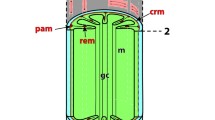Abstract
Each tentacle of the cubopolyp Carybdea marsupialis is armed with only a single nematocyte at its tip. The correct position of the nematocyte is maintained by a crown-shaped cup formed by the mesoglea. In maximally contracted tentacles, the nematocyte and 7–10 surrounding accessory cells are completely retracted into an ectodermal invagination. A belt of muscle cells revealing a distinct cross-striation in specimens labelled with fluorescein-isothiocyanate-phalloidin is located around the basal part of the nematocyte. These muscle cells are linked both to the mesogleal cup and to the nematocyte by specialized desmosomal contact zones. An additional set of long slender muscle strands runs through the complete length of the tentacles. Their myofibrils reveal only a weak striation pattern. Whereas the contraction of the tentacles seems to depend on the slender muscle strands, the retraction of the apical cell complex is thought to be mediated by the cross-striated muscle belt.
Similar content being viewed by others
References
Agosti CG, Stidwill RP (1991) In vitro migration of Hydra nematocytes: the influence of the natural extracellular matrix (the mesoglea), of collagen type IV and type I, laminin, and fibronectin on cell attachment, migration parameters, and on patterns of cytoskeletal proteins. Cell Motil Cytoskeleton 20:215–227
Agosti CG, Stidwill RP (1992) The contributions of microtubules and F-actin to the in vitro migratory mechanisms of Hydra nematocytes as determined by drug interference experiments. Exp Cell Res 200:196–204
Anderson PAV, Schwab WE (1981) The organization and structure of nerve and muscle in the jellyfish Cyanea capillata (Coelenterate; Scyphozoa). J Morphol 170:383–399
Campbell RD (1988) Migration of nematocytes in hydrozoans. In: Hessinger DA, Lenhoff HM (eds) The biology of nematocysts. Academic Press; San Diego, pp 123–143
Chapman DM (1978) Microanatomy of the cubopolyp, Tripedalia cystophora (Class Cubozoa). Helgoländer Wiss Meeresunters 31:128–168
Chapman G (1974) The skeletal system. In: Muscatine L, Lenhoff HM (eds) Coelenterate biology. Academic Press, New York, pp 93–128
Cormier SM, Hessinger DA (1980) Cnidocil apparatus: sensory receptor of Physalia nematocytes. J Ultrastruct Res 72:13–19
Golz R (1993) Comparison of cytoskeletal elements and intracellular membranes in migrating and tissue-integrated nematocytes of the marine hydrozoon Coryne spec. Eur J Cell Biol 60:34
Golz R, Thurm U (1991) Cytoskeleton-membrane interactions in the cnidocil complex of hydrozoan nematocytes. Cell Tissue Res 263:573–583
Golz R, Thurm U (1993) Ultrastructural evidence for the occurrence of three types of mechanosensitive cells in the tentacles of the cubozoan polyp Carybdea marsupialis. Protoplasma 173:13–22
Hausmann K, Holstein T (1985) Bilateral symmetry in the cnidocilnematocyst complex of the freshwater medusa Craspedacusta sowerbii Lankester (Hydrozoa, Limnomedusae). J Ultrastruct Res 90:89–104
Holley MC (1985) Changes in the distribution of filament-containing septate junctions as coelenterate myoepithelial cells change shape. Tissue Cell 17:1–11
Holstein T, Tardent P (1984) An ultrahigh-speed analysis of exocytosis: nematocyst discharge. Science 223:830–833
Hufnagel LA, Kass-Simon G, Lyon MK (1985) Functional organization of battery cell complexes in tentacles of Hydra attenuata. J Morphol 184:323–341
Kass-Simon G (1988) Towards a neuroethology of nematocyst discharge in the tentacles of Hydra. In: Hessinger DA, Lenhoff HM (eds) The biology of nematocysts. Academic Press, San Diego, pp 531–541
Kinnamon JC, Westfall JA (1982) Types of neurons and synaptic connections at hypostome-tentacle junctions in Hydra. J Morphol 173:119–128
Lehn H (1951) Teilungsfolgen und Determination von I-Zellen für die Cnidenbestimmung bei Hydra. Z Naturforsch [C] 6b:388–391
Mariscal RN (1974) Nematocysts. In: Muscatine L, Lenhoff HM (eds) Coelenterate biology. Academic Press, New York, pp 129–178
Martin VJ, Chia FS (1982) Fine structure of a scyphozoan planula, Cassiopea xamachana. Biol Bull 163:320–328
Peteya DJ (1975) The ciliary-cone sensory cell of anemones and cerianthids. Tissue Cell 7:243–252
Rifkin JF, Endean R (1988) The structure and function of nematocysts of Chironex fleckeri Southcott, 1956. Cell Tissue Res 233:563–577
Sarras MP, Madden ME, Zhang XM, Gunwar S, Huff JK, Hudson BG (1991) Extracellular matrix (mesoglea) of Hydra vulgaris. I. Isolation and characterization. Dev Biol 148:481–494
Schmid V, Bally A, Beck K, Haller M, Schlage WK, Weber C (1991) The extracellular matrix (mesoglea) of hydrozoan jelly-fish and its ability to support cell adhesion and spreading. Hydrobiologia 216/217:3–10
Slautterback DB (1967) The cnidoblastmusculo-epithelial cell complex in the tentacles of Hydra. Z Zellforsch 79:296–318
Westfall JA (1970) The nematocyte complex in a hydromedusan, Gonionemus vertens. Z Zellforsch 110:457–470
Westfall JA (1988) Presumed neuronematocyte synapses and possible pathways controlling discharge of a battery of nematocysts in Hydra. In: Hessinger DA, Lenhoff HM (eds) The biology of nematocysts. Academic Press, San Diego, pp 41–51
Wood RL (1959) Intercellular attachment in the epithelium of Hydra as revealed by electron microscopy. J Biophys Biochem Cytol 6:343–352
Wood RL, Novak PL (1982) The anchoring of nematocysts and nematocytes in the tentacles of Hydra. J Ultrastruct Res 81:104–116
Ziegler U, Stidwill RP (1992) The attachment of nematocytes from the primitive invertebrate Hydra to fibronectin is specific and RGD-dependent. Exp Cell Res 202:281–286
Author information
Authors and Affiliations
Rights and permissions
About this article
Cite this article
Golz, R. Anchorage and retraction of nematocytes in the tentacles of the cubopolyp Carybdea marsupialis are mediated by a species-specific mesogleal support. Cell Tissue Res 274, 173–180 (1993). https://doi.org/10.1007/BF00327998
Received:
Accepted:
Issue Date:
DOI: https://doi.org/10.1007/BF00327998




